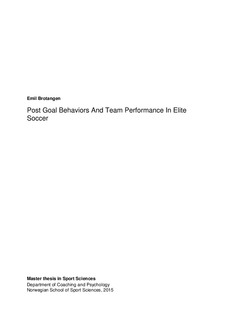| dc.description.abstract | This study explored nonverbal behaviors displayed after a goal was scored in
regular soccer games (post goal behaviors). After developing the post goal behavioral
coding scheme in soccer (the PGB-CS-S), 226 post goal behaviors and two intensity
measures from 208 post goal periods stemming from 120 elite soccer games involving
16 teams were coded. Chi-square tests were used to investigate the relationship between
a) post goal behaviors and the standing in the match prior to the goal was scored as
predictor of post goal behaviors, and b) post goal behaviors and the game outcome of
regular soccer games. The chi-square tests revealed no significant findings at p<0.05
after Bonferroni corrections were conducted. However, due to the critique of the
Bonferroni corrections of being too conservative (Perneger 1998; Narum, 2006), a
selection of the significant findings prior to the corrections are discussed in the paper.
Furthermore, linear regression analysis were conducted to examine possible predictors
of the intensity of post goal behaviors, and the hypothesis that intensity of post goal
behaviors predicted game outcome. The results gave a detailed description of the post
goal behaviors displayed. Furthermore, the results of the linear regression analysis
revealed the following predictors of post goal behaviors: higher attendance at the
stadium was associated with higher intensity of the post goal behaviors, higher number
of times the team regained the ball prior to the goal was scored, led to higher intensity
of the post goal behaviors, scoring a goal by out-maneuvering a team in balance was
associated with higher intensity, and attacks starting with a set piece far away from the
goal (goal-kick and kick off) was associated with higher intensity than set pieces closer
to the goal (corner-kick and penalty kick). Ultimately, the results revealed that the
higher intensity of the post score behavior, the higher chance that the player was on a
team that ended up winning the game. The results are interpreted in terms of the
mechanism of emotional contagion and schema-driven impression formation. The
results of the present study suggests that the intensity of the individual postperformance
expressions in the period after a goal is scored in soccer serves a direct
purpose in enhancing the player’s likelihood of being on the team that ultimately wins
the game in regular soccer games. | nb_NO |
